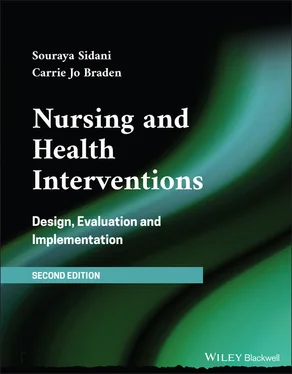The limitations of literature reviews relate to the (often limited) availability of well‐planned and executed studies that investigated the health problem. Where available, there is the potential for publication bias (Chan et al., 2014), non‐replication of findings, or having mixed or inconclusive findings, all of which weaken the confidence in the validity or accuracy of the generated knowledge, and hence its utility in informing the design of interventions (Ioannidis et al., 2014: Van Assen et al., 2015).
3.3.2.2 Conduct of Primary Studies
Overview
The decision to conduct a primary study to understand the health problem is made when: (1) there is a small number of studies that investigated the problem, thereby limiting the knowledge of the problem experience and its determinants; (2) the quality of available studies is appraised as low, which may be related to a range of conceptual and methodological concerns, such as unclear definition of the health problem, omission of theoretically important determinants, and use of measures with questionable reliability and validity; and (3) available studies have not investigated the health problem in the client population and context of interest, raising questions about the relevance and applicability of available evidence to the target population and context.
The primary studies can be prospective quantitative, qualitative, or mixed (quantitative and qualitative, concurrent, or sequential) method. Mixed‐method studies are promising in generating a comprehensive, in‐depth understanding of the problem as experienced by the target population in the particular context of interest.
The process for planning and conducting primary studies is well described in basic and advanced research textbooks, and is not reviewed here. However, some key considerations are briefly mentioned.
The main focus of the study is on the health problem and its determinants, as experienced by the target client population in the context of interest.
The study is designed to address the specific gap in knowledge about the problem as experienced by the target client population and the context of interest. Quantitative, cross‐sectional or longitudinal studies aim to: (1) describe the experience of the problem (e.g. frequency of occurrence, severity, most common indicators) and its determinants and consequences at one point in time, or changes in the problem experience and determinants over time; (2) examine factors that operate at different levels and contribute most significantly to the problem as experienced by the target client population and the context of interest; or (3) test the theory of the problem derived from relevant middle range theories or empirical evidence. Qualitative studies can be designed to: (1) generate inductively the conceptualization of the health problem held by the target client population, or (2) elicit clients' perceptions of the determinants and consequences, as well explanations of the inter‐relationships among determinants, problem, and consequences. The gaps in knowledge to address dictate the general research approach to utilize.
The specific research design and methods (e.g. online survey, face‐to‐face unstructured interviews) are selected for their consistency and appropriateness in addressing the study aims. The choice of methods should take into account the size of the accessible client population and anticipated response rate (e.g. low response rates have been reported for some populations like immigrant older adults); logistics of client recruitment in the context of interest (e.g. it may be hard to reach community‐dwelling substance users); the preference or comfort of the client population with specific research methods (e.g. ability to access a computer, and skills enabling completion of online surveys); availability of validated instruments that measure the problem, determinants and consequences; and ability to access human and material resources required to conduct the study within a reasonable time frame.
The data collection procedures are carefully planned and executed in order to minimize the potential for response burden and introduction of biases (such as acquiescence, social desirability) that threaten the validity of findings.
The data analysis is done rigorously, using appropriate analytic techniques that allow the determination of factors that most significantly contribute to the problem experience, the delineation of the inter‐relationships (direct and indirect) among the determinants and the problem, and the elucidation of the clients' explanations of these inter‐relationships.
Conducting primary studies is advantageous in generating an understanding of the health problem. Large‐scale quantitative studies that use validated measures of the problem and determinants provide opportunities to identify the most influential determinants and to delineate their direct and indirect influence on the problem, as experienced by the client population and in the context of interest. The use of psychometrically sound measures enhances construct validity. Qualitative studies have the advantage of capturing the target client population's views of the problem and explanations of how factors occurring at different levels inter‐relate or interact in influencing the problem. The integration of quantitative and qualitative findings in mixed‐method studies is effective in enhancing the validity and applicability of the knowledge of the problem to the client population and context of interest.
The conduct of primary studies is resource intensive and time consuming. It is often limited by potential biases associated with the inadequacy of the accrued sample size, restricted representation of all subgroups comprising the target client population, and the quality of the obtained data (e.g. missing data that reduce statistical power to detect significant relationships among determinants and problem; and non‐normal response distribution that constrains the use of powerful statistical tests). Analysis of available data is a means to overcome some of these limitations
3.3.2.3 Analysis of Available Data
Overview
Large volumes of health and social data are collected by national and international groups of researchers, as well as healthcare, governmental, and nongovernmental agencies. These data are obtained through regularly scheduled surveys of the general population (e.g. Canadian Longitudinal Study on Aging, involving collection of data on a wide range of health indices from 30 000 persons, every five years; Healthy Aging and Retirement in Europe as mentioned by Hoffman et al., 2018); or routine assessment of health indices for clients using healthcare services, that is done in practice and compiled in administrative or claims data (e.g. Ammendolia et al., 2016). Electronic copies of these data are available for analysis aimed to describe the health problem and its associations with relevant determinants in the target client population and context. For instance, Sidani and Guruge (unpublished report) analyzed the first wave of data obtained by the Canadian Longitudinal Study on Aging to determine differences in the experience of insomnia between Canadian‐born and immigrant older adults. Preliminary findings showed variability in the experience and the determinants of insomnia. Canadian‐born older adults reported experiencing difficulty initiating sleep more frequently than immigrants, which was associated with having pain or discomfort and with lower level of education.
After determining the availability of a data set, the process for accessing the electronic copy starts. The process varies with the requirements of the agencies that own the data. For instance, there is a website for the Canadian Longitudinal Study on Aging that provides general information about the study, the specific variables measured (e.g. demographic, cognitive, sleep problems), and the process for acquiring a copy of the data of interest. This process consists of completing a request form that is approved by the research team, and of signing a confidentiality form. Once the data file is obtained, it should be carefully reviewed to get a clear understanding of the variables and their measurement, which has implications for planning the data analysis. The analysis follows the conventional steps of: (1) conducting descriptive statistics to examine the distribution of the data and the extent of missing data for each variable; (2) handling missing data with the most appropriate method (e.g. McKnight et al., 2007); (3) computing total scale scores for variables measured by multi‐item scales; and (4) performing relevant correlational analyses to investigate the direct associations between the health problem and each determinant (e.g. bivariate correlation) or a set of determinants (e.g. regression analysis); the indirect relationships among the determinants and the problem (e.g. structural equation modeling); and/or the moderating effect of a factor (e.g. multigroup analysis).
Читать дальше












